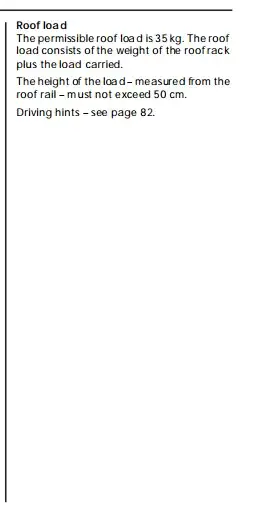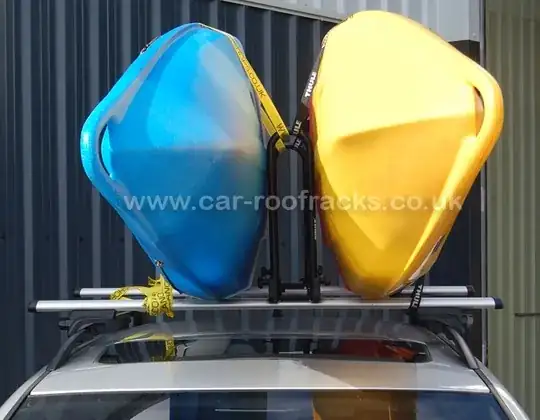Would this be safe?
tl;dr: No. It's hard to say exactly how unsafe or how bad the consequences might be.
Assuming the rails themselves weigh on the order of 5-10 kg, you're talking about almost doubling the advised load on the whole system.
From reading that advisory, it's hard to say exactly what failure modes their mechanical engineers are expecting. For the sake of discussion, let's assume point loads as well as shearing and twisting forces (all of which seem reasonable given your "two kayaks driving 80 mph" scenario).
Assuming the rails themselves weigh on the order of 5-10 kg, you're talking about almost doubling the advised load.
Point loads: I can think of several point loads that this system is going to experience. The mounts of the base rails (the rails running the length of the car) will be overloaded. The connection points of the cross rails will also be overloaded. The cross rails themselves will also be overloaded. You should expect that the connections will all have some play after this trip. The rails will also likely be slightly to significantly deformed.
Shearing: Kayaks are always big sails, no matter what you cover. Any cross breeze (which can be significant at these speeds) are going to act to try to pry the cross rails away from the base rails. I'd also expect them to try to pry the base rails away from the vehicle. As the connection points will now have some extra play, shearing will be that much more effective.
Twisting: I'd expect this to be fairly dramatic. Every time those big sails take even a slight angle to the wind, they'll be trying to twist themselves right off. Again, this will be working all the connection points and torquing the rails in ways with greater mass.
Will any of this lead to the rails ripping off the roof? That's hard to say.
I wouldn't be surprised if the rails rattled quite a bit after this trip and were significantly bent. At that point, the whole system is compromised and you can't confidently expect that it will safely hold any weight. Anything like that would make me crazy since I'd know it was my fault for breaking my car.
Best of all, if you consider all this and do it anyway and something does go wrong, it's on you. The manufacturer has made it clear that you've gone well outside their engineering guidance. If it fails, they told you so.
Disclaimer: this is not what I'm a doctor of. However, I do work with mechanical engineers and their advisories of "stay within these guidelines if you don't want to break anything" are serious and well-grounded. I tend to respect their expertise.
EDIT 31 July 2015: Coincidentally, I saw a set-up very similar to the one pictured above yesterday. It was at the top of one of our local bridges where the winds were modest (no whitecaps on the waves below) and the speeds were about 50 mph.
Unfortunately, the kayak and the vertical piece were lying in the middle of the road. The crossbeams and the lengthwise rails were lying in the other lane. This lead to much creative use of language as I tried to maneuver around the road debris while in rush-hour traffic.
So, I stand by my original statement: it's not safe. I have a little more knowledge about the failure modes, though: they're incredibly annoying with a distinct tinge of "very dangerous."

